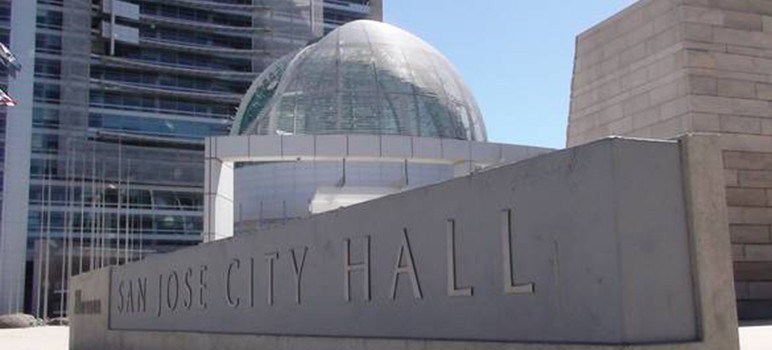Anyone who regularly attends San Jose City Council has had to endure more than a few sweltering meetings this past year, including a particularly hellish stretch last fall.
At the time, city staff positioned some industrial-sized fans in the chambers, where they remain to this day in case the AC system decides to crap out again—which it did a number of times over the ensuing months.
The good news is that it’s getting fixed. The council budgeted $9 million to remedy the problem. The bad news? It’ll take about a year to install the new setup.
“Because of the size of our system and the size of our campus, it will take about 12 months, we think,” explained Walter Lin, the deputy director of San Jose’s Public Works Department. “But we do have a priority listing. We’ll be going from larger spaces first, such as the City Council chambers and the rotunda, to our wing facility. Then, our goal is to start from the upper floors on the tower side and go down from there.”
What’s being replaced isn’t the physical HVAC system but the software that controls it. San Jose’s modern 18-story City Hall may have opened just 14 years ago, but its HVAC software dates back to the early 2000s.
“The analogy that we try to use is that if you have the original iPhone and try to use it today, you’re going to have a lot of glitches and challenges,” he said. “And even Apple isn’t going to be help you through that process.”
Part of what’s been so aggravating for Lin’s public works team, he said, is that the software is a legacy proprietary system, which forces the city to depend on Honeywell, the company that made it, to sort things out.
“So that ties out hands a little bit,” he said. “We rely on their services to help, but the system is so old that there isn’t much that even they could do sometimes. We’ve been kind of working and making some adjustments to get cooling and heating when needed. That’s a challenge on an older software platform.”
What that translates to in the physical realm is a range of temperatures throughout City Hall, with some floors too hot and others too cold. Ideally, Lin said the temperatures throughout the building will range from 70 to 74 degrees, but some floors during localized outages have been reaching the upper 70s or low-to-mid-80s.
The new contractor hired by the city is Sunbelt Controls, which offers a technology that’s not proprietary and, according to Lin, is “more open source.”
“That will allow us to maintain and control things a lot better,” he said.
For the most part.
Lin’s staff will still deal with the HVAC system’s inevitable physical failures as they arise. Like, for example, the pipe that burst and flooded the building’s chilling room earlier this week. Thankfully, his team fixed it in time to keep things cool.
“We just wrapped the pipe until we could properly weld it shut and replenished the water as it was leaking,” he said, “so the chilling effect wasn’t impacted too badly.”
Still, as the Bay Area experiences a heat wave that’s pushing temps into the triple digits this week, City Hall staffers looking for some reprieve might be better off hitching a free VTA bus ride to one of Santa Clara County’s 41 designated cooling centers.


The taxpayers of San Jose spent 384 million dollars on a building that is what 14 years old and they put in software that came from the 1990’s. Who the hell got away with bank robbery?
the building opened in `05 so the SW from the 90s was only 5yrs old at that point
What do you expect from a mayor, council , and staff with little or no business experience?
The city has been out negotiated by labor, contractors, and vendors consistently since I have lived in SJ starting in the mid-1970’s
Eh, what’s $9M of other people’s money. No big deal. As long as we keep voting them in and voting for higher taxes, this is what we get in return.
16 more day’s I won’t be paying there higher tax’s someone else will!
> 16 more day’s I won’t be paying there higher tax’s someone else will!
Not so fast.
I’ve heard that the legislature is rushing through a bill to put a lien on your carbon footprint.
Should be signed into law within 15 days.
Requires you to post a bond if your carbon footprint leaves the state, as well as paying semi-annual bond servicing charges.
Fixing the AC at City Hall is just a big waste of money.
It’s all going to be under water in a year or two anyway.
https://sjoutsidethebubble.files.wordpress.com/2019/08/risingsealevel01c.jpg
A year to write software for a single HVAC system???